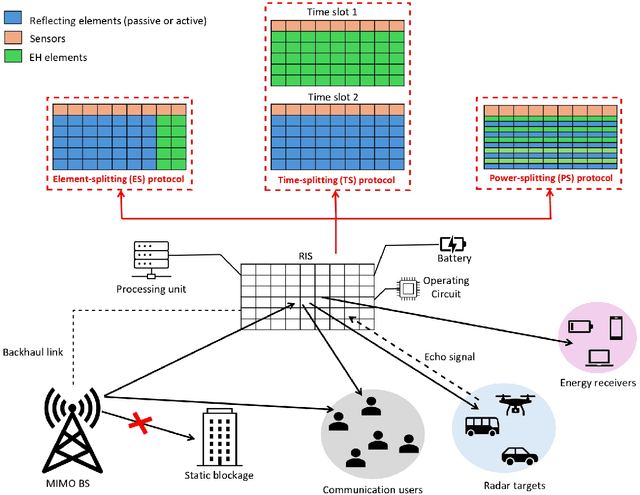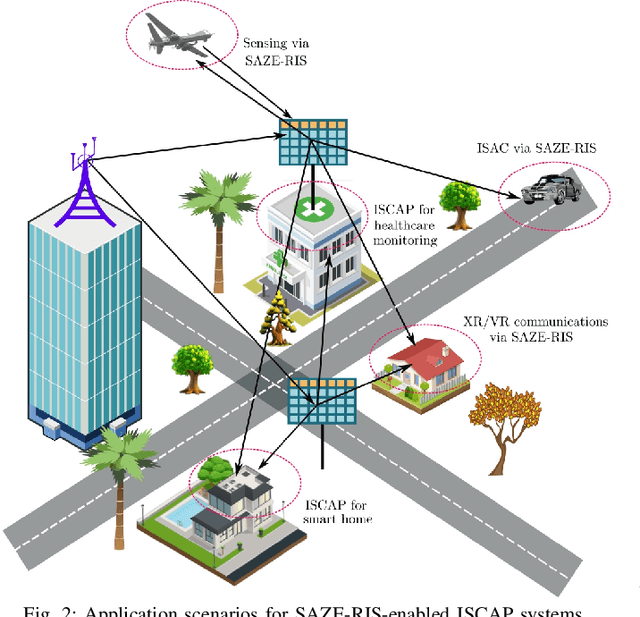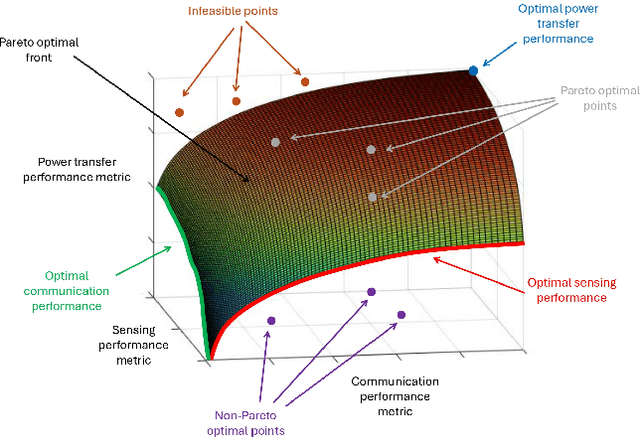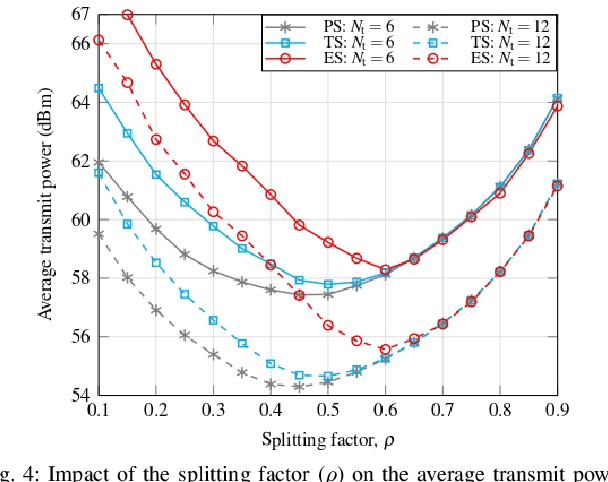Mark F. Flanagan
Senior Member, IEEE
Hiding in Plain Sight: RIS-Aided Target Obfuscation in ISAC
Mar 07, 2025Abstract:Integrated sensing and communication (ISAC) has been identified as a promising technology for the sixth generation (6G) of communication networks. Target privacy in ISAC is essential to ensure that only legitimate sensors can detect the target while keeping it hidden from malicious ones. In this paper, we consider a downlink reconfigurable intelligent surface (RIS)-assisted ISAC system capable of protecting a sensing region against an adversarial detector. The RIS consists of both reflecting and sensing elements, adaptively changing the element assignment based on system needs. To achieve this, we minimize the maximum sensing signal-to-interference-plus-noise-ratio (SINR) at the adversarial detector within sample points in the sensing region, by optimizing the transmit beamformer at the base station, the RIS phase shift matrix, the received beamformer at the RIS, and the division between reflecting and absorptive elements at the RIS, where the latter function as sensing elements. At the same time, the system is designed to maintain a minimum sensing SINR at each monitored location, as well as minimum communication SINR for each user. To solve this challenging optimization problem, we develop an alternating optimization approach combined with a successive convex approximation based method tailored for each subproblem. Our results show that the proposed approach achieves a 25 dB reduction in the maximum sensing SINR at the adversarial detector compared to scenarios without sensing area protection. Also, the optimal RIS element assignment can further improve sensing protection by 3 dB over RISs with fixed element configuration.
Sensing Rate Optimization for Multi-Band Cooperative ISAC Systems
Mar 05, 2025Abstract:Integrated sensing and communication (ISAC) has been recognized as one of the key technologies for future wireless networks, which potentially need to operate in multiple frequency bands to satisfy ever-increasing demands for both communication and sensing services. Motivated by this, we consider the sum sensing rate (SR) optimization for a cooperative ISAC system with linear precoding, where each base station (BS) works in a different frequency band. With this aim, we propose an optimization algorithm based on the semi-definite rank relaxation that introduces covariance matrices as optimization variables, and we apply the inner approximation (IA) method to deal with the nonconvexity of the resulting problem. Simulation results show that the proposed algorithm increases the SR by approximately 25 % and 40 % compared to the case of equal power distribution in a cooperative ISAC system with two and three BSs, respectively. Additionally, the algorithm converges in only a few iterations, while its most optimal implementation scenario is in the low power regime.
Optimal Beamforming Design for ISAC with Sensor-Aided Active RIS
Oct 16, 2024Abstract:Active reconfigurable intelligent surfaces (RISs) can improve the performance of integrated sensing and communication (ISAC), and therefore enable simultaneous data transmission and target sensing. However, when the line-of-sight (LoS) link between the base station and the sensing target is blocked, the sensing signals suffer from severe path loss, resulting in an inferior sensing performance. To address this issue, this paper employs a sensor-aided active RIS to enhance ISAC system performance. The goal is to maximize the signal-to-noise ratio of the echo signal from the target at the sensor-array while meeting constraints on communication signal quality, power budgets, and RIS amplification limits. The optimization problem is challenging due to its non-convex nature and the coupling between the optimization variables. We propose a closed-form solution for receive beamforming, and a successive convex approximation based iterative method for transmit and reflection beamforming design. Simulation results demonstrate the advantage of the proposed sensor-aided active RIS-assisted system model over its non-sensor-aided counterpart.
Multi-Functional RIS for a Multi-Functional System: Integrating Sensing, Communication, and Wireless Power Transfer
Oct 11, 2024



Abstract:Communication networks are evolving from solely emphasizing communication to facilitating multiple functionalities. In this regard, integrated sensing, communication, and powering (ISCAP) provides an efficient way of enabling data transmission, radar sensing, and wireless power transfer simultaneously. Such a multi-functional network requires a multi-functional architectural solution. Toward this end, sensor-aided zero-energy reconfigurable intelligent surfaces (SAZE-RISs) offer an energy-efficient solution for ISCAP by meeting the requirements of the end users as well as supplying power for the RIS. This paper explores the use of SAZE-RIS within the ISCAP framework. First, we present the general system architecture, operational protocols, and main application scenarios for employing SAZE-RIS in ISCAP. Next, we discuss methods for managing the conflicting requirements of communication, sensing, and powering within ISCAP and the role of SAZE-RIS in this process. We then provide a detailed case study complete with simulation results, offering valuable insights into the design choices and tradeoffs that come into play when adopting this technology. Furthermore, we discuss the related challenges and open research avenues, highlighting areas that require further exploration to fully realize the potential of SAZE-RIS within this ISCAP framework.
Opportunistic User Scheduling for Secure RIS-aided Wireless Communications
Mar 05, 2024Abstract:In this paper, we provide expressions for the secrecy outage probability (SOP) for suboptimal and optimal opportunistic scheduling schemes in a reconfigurable intelligent surface (RIS) aided system with multiple eavesdroppers in approximate closed form. A suboptimal scheduling (SS) scheme is analyzed, which is used when the channel state information (CSI) of the eavesdropping links is unavailable, and the optimal scheduling (OS) scheme is also analyzed, which is used when the global CSI is available. For each scheme, we provide a simplified expression for the SOP in the high signal-to-noise ratio (SNR) regime to demonstrate its behavior as a function of the key system parameters. At high SNR, the SOP saturates to a constant level which decreases exponentially with the number of RIS elements in the SS scheme and with the product of the number of RIS elements and the number of users in the OS scheme. We compare the performance of the opportunistic user scheduling schemes with that of a non-orthogonal multiple access (NOMA) based scheduling scheme which chooses a pair of users in each time slot for scheduling and we show that the opportunistic schemes outperform the NOMA-based scheme. We also derive a closed-form expression for the SOP of a decode-and-forward (DF) relay-aided scheduling scheme in order to compare it with that of the RIS-aided system. It is found that the RIS-aided system outperforms the relay-aided systems when the number of RIS elements is sufficiently large. An increased number of RIS elements is required to outperform the relay-aided system at higher operating frequencies.
A Survey on Integrated Sensing and Communication with Intelligent Metasurfaces: Trends, Challenges, and Opportunities
Jan 28, 2024Abstract:The emergence of various technologies demanding both high data rates and precise sensing performance, such as autonomous vehicles and internet of things devices, has propelled an increasing popularity of integrated sensing and communication (ISAC) in recent years. ISAC offers an efficient framework for communication and sensing where both functionalities are carried out in a shared spectrum, utilizing the same hardware, beamformer and waveform design. At the same time, intelligent metasurfaces have been identified as an architectural enabler for the upcoming sixth-generation (6G) of wireless communication due to their ability to control the propagation environment in an energy-efficient manner. Due to the potential of metasurfaces to enhance both communication and sensing performance, numerous papers have explored the performance gains of using metasurfaces to improve ISAC. This survey reviews the existing literature on metasurface-assisted ISAC, detailing the associated challenges and opportunities. To provide a comprehensive overview, we commence by offering relevant background information on standalone metasurface-assisted communication and metasurface-assisted sensing systems, followed by a discussion on the fundamentals of ISAC. The core part of the paper then summarizes the state-of-the-art studies on metasurface-assisted ISAC with metasurfaces employed as separate entities placed between the transmitter and receiver, also known as reconfigurable intelligent surfaces, with an emphasis on its two levels of integration: radio-communications co-existence and dual-function radar-communications. We also review the current works in the area of holographic ISAC where metasurfaces are used to form part of ISAC transmitter. Within each category, the challenges, opportunities and future research directions are also highlighted.
RIS-Assisted Generalized Receive Quadrature Spatial Modulation
Nov 30, 2023Abstract:In this paper, reconfigurable intelligent surface (RIS)-assisted generalized receive quadrature spatial modulation (RIS-GRQSM) is proposed to improve the spectral efficiency of RIS-aided quadrature spatial modulation (QSM) systems by utilizing the concept of generalized spatial modulation (GSM). That is, multiple antennas are activated at the receiver independently for both the real and imaginary parts. We propose a max-min optimization problem to adjust the phase shifts of all RIS elements to maximize the relevant signal-to-noise ratios (SNRs) at all activated receive antennas. Using Lagrange duality, the non-convex optimization problem involving the phase shifts of all RIS elements reduces to a convex optimization involving a number of variables equal to the number of activated receive antennas. A successive greedy detector (GD) can be used at the receiver to detect the active antennas, which simplifies the detection process. The numerical results show that the proposed scheme outperforms the benchmark schemes in terms of error rate performance, especially in systems with a larger number of receive antennas. In the special case where each receive antenna corresponds to a user and is activated, the RIS-GRQSM system becomes a multicast communication system. In this context, in contrast to existing phase shift optimization algorithms which exhibit an impractical level of complexity, our proposed solution offers the advantage of low complexity and practical feasibility of implementation.
Robust Beamforming Design for Energy Efficiency and Fairness Maximization in RIS-Assisted mmWave Communications
Jul 03, 2023Abstract:The use of reconfigurable intelligent surfaces (RISs) has been proposed in the past few years to achieve a better communication system performance by creating a programmable wireless propagation environment. In this paper, we target maximizing both energy efficiency and user fairness in RIS-assisted millimeter-wave systems with imperfect channel state information. We formulate the energy efficiency and fairness maximization problem as a multi-objective optimization problem. We split the corresponding multi-objective optimization problem into two stages using a lexicographic approach. In the first stage, the energy efficiency is maximized; then in the second stage, the fairness is maximized subject to a maximum reduction in the optimal value of the energy efficiency. We propose a projected gradient ascent based alternating optimization procedure to solve the optimization problem in each stage. We further employ the penalty dual decomposition method to address the challenging energy efficiency constraint in the second stage. Simulation results show that the proposed algorithm can achieve a better trade-off between energy efficiency and fairness compared to the methods that target only one of those metrics.
Destination Scheduling for Secure Pinhole-Based Power-Line Communication
Jun 06, 2023



Abstract:We propose an optimal destination scheduling scheme to improve the physical layer security (PLS) of a power-line communication (PLC) based Internet-of-Things system in the presence of an eavesdropper. We consider a pinhole (PH) architecture for a multi-node PLC network to capture the keyhole effect in PLC. The transmitter-to-PH link is shared between the destinations and an eavesdropper which correlates all end-to-end links. The individual channel gains are assumed to follow independent log-normal statistics. Furthermore, the additive impulsive noise at each node is modeled by an independent Bernoulli-Gaussian process. Exact computable expressions for the average secrecy capacity (ASC) and the probability of intercept (POI) performance over many different networks are derived. Approximate closed-form expressions for the asymptotic ASC and POI are also provided. We find that the asymptotic ASC saturates to a constant level as transmit power increases. We observe that the PH has an adverse effect on the ASC. Although the shared link affects the ASC, it has no effect on the POI. We show that by artificially controlling the impulsive to background noise power ratio and its arrival rate at the receivers, the secrecy performance can be improved.
Secrecy of Opportunistic User Scheduling in RIS-Aided Systems: A Comparison with NOMA Scheduling
Jun 05, 2023Abstract:In this paper, we propose an opportunistic user scheduling scheme in a multi-user reconfigurable intelligent surface (RIS) aided wireless system to improve secrecy. We derive the secrecy outage probability (SOP) and its asymptotic expression in approximate closed form. The asymptotic analysis shows that the SOP does not depend on the transmitter-to-RIS distance and saturates to a fixed value depending on the ratio of the path loss of the RIS-to-destination and RIS-to-eavesdropper links and the number of users at high signal-to-noise ratio. It is shown that increasing the number of RIS elements leads to an exponential decrease in the SOP. We also compare our scheme with that of a non-orthogonal multiple access (NOMA) scheduling scheme, which chooses a pair of users to schedule in each time slot. The comparison shows that the SOP of all of the NOMA users is compromised, and that our proposed scheduling scheme has better performance.
 Add to Chrome
Add to Chrome Add to Firefox
Add to Firefox Add to Edge
Add to Edge